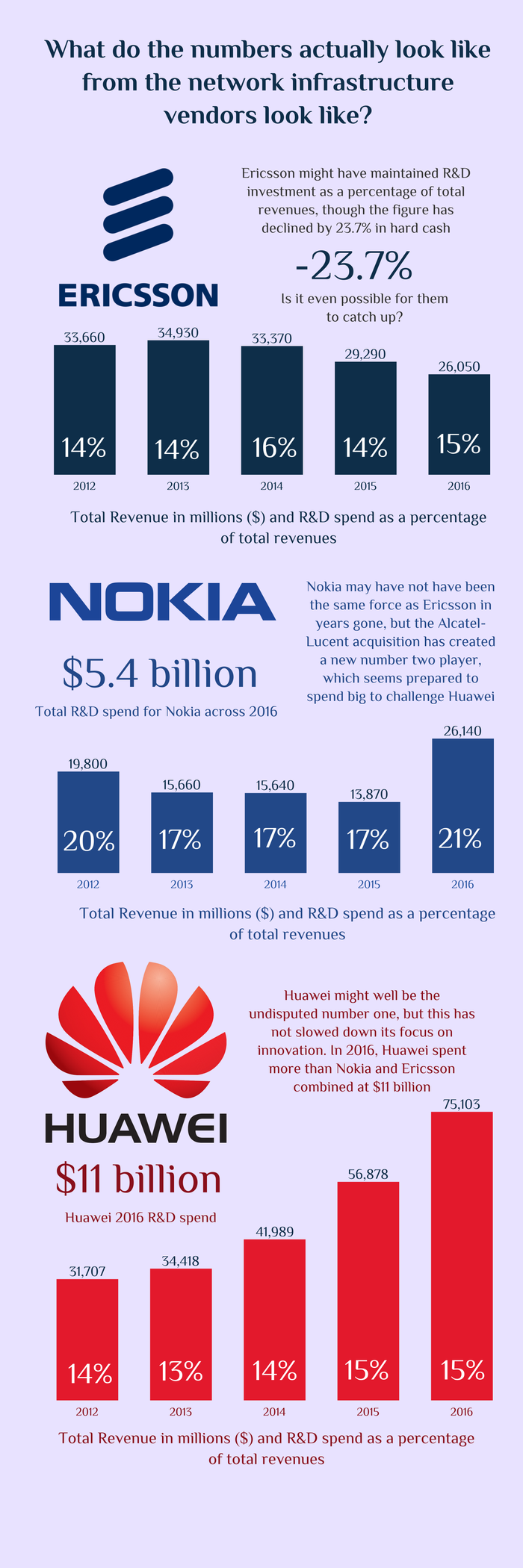Ericsson is losing the R&D game and that needs to change
Huawei is proving why its number one in the infrastructure world; a relentless pursuit of innovation which is making Nokia and Ericsson look positively pedestrian.
June 5, 2017

Huawei is proving why its number one in the infrastructure world: a relentless pursuit of innovation which is making Nokia and Ericsson look positively pedestrian.
The statistics, which you can have a look at if you scroll down, tell a story thatwill surprise few. R&D is certainly a focus for all three of the network infrastructure vendors, and Huawei is leading the charge. It brings in the most amount of revenue, therefore this should be unsurprising, but a continued focus on innovation is a clear message from Huawei.
Many would have forgiven the giant for reducing the proportion of revenues it attributed to R&D, after all, 2016 saw $11 billion pushed into innovation. Huawei has continued to invest 15% of total revenues into R&D; even if this percentage was to decrease to 10% that would have been $7.3 billion last year – still the biggest spender in the world. Its spend currently exceeds the combined value of both Nokia and Ericsson R&D budgets.
Nokia is an interesting story however. The challenge of Huawei could be seen by some as a wake-up call, and the kick-start it needed to get back on track.
In the last few years, Nokia has got rid of non-core, or underperforming, business units which were distracting the core network infrastructure business. HERE was sold to a consortium of automotive companies for €2.55 billion in 2015, while it got rid of luxury mobile brand Vertu in 2012 and the rest of its Devices & Services business to Microsoft a year later for €5.44 billion.
Investment levels in R&D have been varied over the last five years, though they have been higher than the average. This was also coupled with the €15.6 billion acquisition of Alcatel-Lucent, which was incorporated into the figures last year. In 2016, Nokia invested roughly $5.4 billion in innovation, around 21% of total revenues.
This is what should be recognized as a statement of intent; sell off the distractions, buy another major player and invest heavily in R&D. Nokia is not leaving any unanswered questions in mounting a challenge to Huawei’s dominance.
The final area is Ericsson, a company which is in a bit of a state at the moment. Now we’re not saying we know how to run a billion-dollar, multi-national corporation, or the intricacies of financing idea-smiths, but there doesn’t seem to be much intent at the moment.
R&D investments have been maintained at 15%, which should be applauded; there must occasionally be pressure from the odd greedy investor to reduce investments and bolster profits. However, total revenues have tumbled sharply, bringing down investment in R&D. In terms of hard cash, Ericsson is spending 23% less compared to five years ago while both Nokia and Huawei have increased cash investment, see below.
Year | Ericsson | Nokia | Huawei |
|---|---|---|---|
2012 | 4,852 | 3,961 | 4,283 |
2013 | 4,932 | 2,616 | 4,417 |
2014 | 5,315 | 2,591 | 5,881 |
2015 | 4,134 | 2,359 | 8,583 |
2016 | 3,702 | 5,428 | 11,000 |
R&D investment in millions ($)
Ericsson has discussed selling off the underperforming assets, been attached to acquisition rumours and gone through numerous restructures, however each time the business does not seem to be in a better position. Nokia has been proactive in answering the challenge, Ericsson has slowly began to circle the drain, gradually shrinking into the shadows of mediocrity.
Turning a super tanker like Ericsson cannot be done overnight, but this is a trend over two to three years. Investment in R&D somehow needs to increase, or at least there needs to be a demonstration it is being directed to the right areas. Useless assets need to be gone to free up cash and remove distractions. New ideas will take Ericsson back to the top, and new ideas require cash.
What is clear, is that the current trend of decreasing investments will only lead to Ericsson becoming redundant as an organization.

About the Author
You May Also Like










.png?width=300&auto=webp&quality=80&disable=upscale)


_1.jpg?width=300&auto=webp&quality=80&disable=upscale)